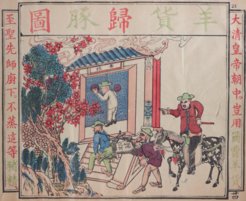The semantic labyrinth of normative mediums:
redefining missionary cases in multi-jurisdictional China (1842-1911)
Haochen Ku

In multi-jurisdictional China, ‘missionary cases’ were clashes of normative knowledge coming from very different agents: from the Chinese, various European states and the Church authorities. To some extent, the legal interactions that occurred in these cases can be seen as navigating a labyrinth: finding the exit (i.e. a solution) was the ultimate goal for all agents, but in the process, each party would encounter many obstacles. These obstacles are the heteroglossia of semantics: although seemingly dealing with the same legal terms, agents had a vastly different understanding of them, corresponding to their own epistemic structures. Rather than simply dealing with legal issues with specific terms, the agents were using legal terms as a lens to gain insights into each other's mindsets. Legal terms can thus be recognized as normative mediums, providing space for each party to be confused, to explore or debate, and to seek a way out of the maze – even though these ‘exits’ were often unexpected and in effect rewrote the history of Sino-Western legal interactions.
As conflicts that stirred up all levels of Chinese society during the very last years of the Chinese Empire, missionary cases show us a variety of legal terms as normative mediums: violence, property, communities, sovereignty, etc. The network composed of these terms explains why legal translation was possible in Late Qing China: new knowledge was produced in semantic practice. All cases were discussed in a highly pragmatic environment and involved various technical issues. The discussions of these technical issues not only show the different semantic contexts of normative mediums under different jurisdictional traditions, but also demonstrate how the agents strove to reach a new solution within these differences.
Thus, this project focuses on these normative mediums and the ‘semantic labyrinth’ behind them. There are abundant sources for the missionary cases: government archives, private diaries, mission reports, travel literature, etc. However, the epistemic structures behind these texts are still to be reconsidered. This project will benefit from Digital Humanities methods to deal with large amounts of text. Through the analysis and organisation of the corpus of ‘missionary cases’, this project will explore the normative mediums that were discussed by contemporary agents but are neglected today, and track how these mediums entered the later legal discourse. These efforts will help us to redefine the ‘missionary cases’, one of the most important public issues at the dawn of imperial China, from a new perspective, and to figure out how these cases presented and shaped legal keywords of China afterwards.
